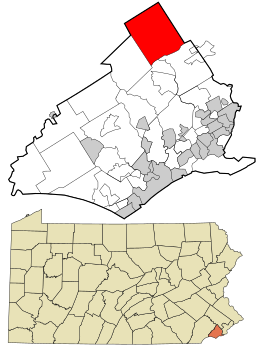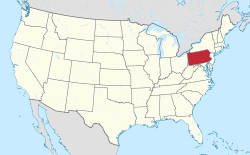Radnor, PA
| Radnor Township | |
|---|---|
| Township with home rule | |

|
|
| Motto: "Best of the Main Line" | |
 Location in Delaware County and the state of Pennsylvania. |
|
 Location of Pennsylvania in the United States |
|
| Coordinates: 40°2′11″N 75°22′21″W / 40.03639°N 75.37250°WCoordinates: 40°2′11″N 75°22′21″W / 40.03639°N 75.37250°W | |
| Country | United States |
| State | Pennsylvania |
| County | Delaware |
| Founded | 1682 |
| Area | |
| • Total | 13.8 sq mi (36 km2) |
| • Land | 13.8 sq mi (36 km2) |
| • Water | 0.0 sq mi (0 km2) |
| Elevation | 381 ft (116 m) |
| Population (2010) | |
| • Total | 31,531 |
| • Estimate (2016) | 31,814 |
| • Density | 2,300/sq mi (880/km2) |
| Time zone | EST (UTC-5) |
| • Summer (DST) | EDT (UTC-4) |
| Area code(s) | 610 |
| FIPS code | 42-045-63264 |
| Website | http://www.radnor.com |
Radnor Township is a township with home rule status in Delaware County, Pennsylvania, United States. It contains the unincorporated communities of Garrett Hill, Rosemont, Strafford, Villanova and Wayne as well a portion of the census designated place of Bryn Mawr. As of the 2010 census, the township population was 31,531. Radnor Township lies along the Main Line, a collection of affluent Philadelphia suburbs.
Villanova University, Cabrini University, the Valley Forge Military Academy and College and Eastern University are all located within Radnor Township.
In 1681 Richard Davies purchased 5,000 acres from William Penn. These lands were sold to various purchasers and were mainly in the location of current Radnor Township. The township was part of the Welsh Tract and was named for Radnorshire in Wales. In 1717, the Welsh Friends erected a Quaker meetinghouse (Radnor Friends Meetinghouse) near what is now the intersection of Conestoga Road and Sproul Road at the geographic center of the township. The new town, "Radnorville", later known as the community of "Ithan" after nearby Ithan Creek, grew around the meetinghouse. The Welsh influence waned in the late 18th century as many left the area due to high taxation. Stone monuments were erected in various locations throughout the township in the late 20th century to commemorate the township's Welsh heritage.
...
Wikipedia
